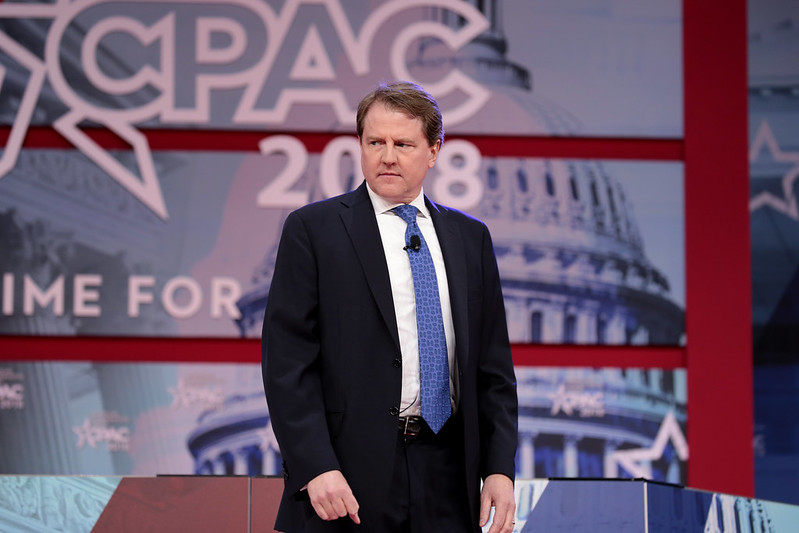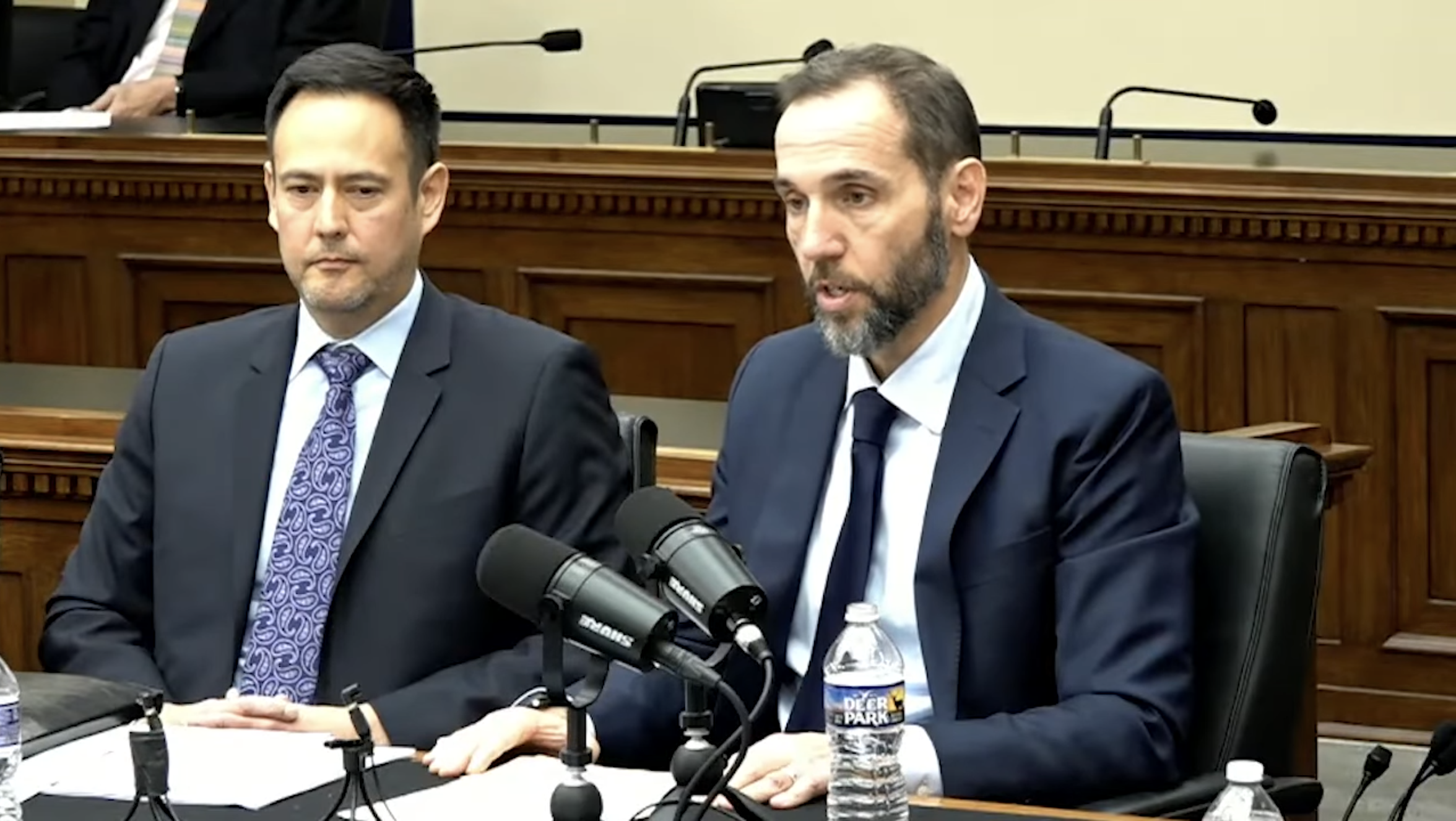Oral Arguments in the D.C. Circuit En Banc Consideration of Committee on the Judiciary v. McGahn and U.S. House of Representatives v. Mnuchin
Judges were skeptical of the Department of Justice’s sweeping arguments but searched for limiting principles on court cases brought by Congress.

Published by The Lawfare Institute
in Cooperation With

On April 28, Justice Department attorneys and attorneys representing the House of Representatives argued by teleconference before the U.S. Court of Appeals for the District of Columbia Circuit, sitting en banc, in two cases concerning Congress’s Article III standing to sue over alleged executive branch illegality: Committee on the Judiciary v. McGahn and U.S. House of Representatives v. Mnuchin.
McGahn concerns whether the House of Representatives can go to court to enforce subpoenas compelling testimony from Trump administration officials. The order granting rehearing en banc vacated a three-judge panel decision from February, which held that the federal courts have no jurisdiction to resolve disputes between the president and Congress over testimony from executive branch officials.
Mnuchin raises similar Article III issues but concerns whether the House of Representatives has standing to sue in district court over the redirection of funding to pay for the U.S.-Mexico border wall. It was also argued before a three-judge panel in February, but the court decided to rehear it en banc along with McGahn before the panel issued its decision. Judges Gregory Katsas and Neomi Rao—both Trump nominees—recused themselves from both cases.
The argument audio is available here:
These two cases were considered together because both present the threshold question of whether the Supreme Court’s decision in Raines v. Byrd bars Congress from vindicating its constitutional powers—including the appropriations power and the need for information to inform the legislative or impeachment powers—in federal courts. That is the sum and substance of the Justice Department’s arguments in both cases, and, on the whole, the panel seemed skeptical of such a sweeping conclusion.
At the same time, there was a clear interest in discerning what limiting principles should apply that would not put the courts in a position of constantly mediating disputes between the Article I and Article II branches. If a congressional committee can come to the courts for subpoena enforcement, and any time there is a disagreement about whether spending by the president is consistent with the Appropriations Clause, can it come to the court whenever a committee perceives that the president has tread on a congressionally assigned power? The judges also seemed to wrestle with the question of whether the need to preserve the balance of power among the three branches of government required them to reject the cases on standing grounds or else decide the cases on the merits.
Notably, some of the judges requested the parties’ views of the Supreme Court’s sua sponte request for supplemental briefing in a separate batch of cases involving access to the president’s financial information “addressing whether the political question doctrine or related justiciability principles bear on the Court’s adjudication of these cases.” Those cases—Trump v. Vance, Trump v. Mazars and Trump v. Deutsche Bank—involve the validity of subpoenas issued for the president’s financial records and are set to be argued on May 12. It is unclear what impact those cases may or may not have on the timing or substance of the en banc court’s decisions on the McGahn or Mnuchin cases.
* * *
Hashim Mooppan, the Justice Department attorney arguing on behalf of McGahn and Mnuchin, begins with an opening statement: Disputes between the political branches about their institutional prerogatives have occurred since the Founding, he says, but lawsuits between them would be novel and unsanctioned. For a case to present, a case or controversy under Article III, there must be a concrete injury that supports standing to sue, and federal courts must look to whether the dispute is traditionally thought to be capable of judicial resolution.
He turns to the Supreme Court’s decision in Raines, which he suggests shows that these types of cases were not historically thought to be appropriate for judicial resolution. Mooppan then continues to the case-specific reasons why the two cases before the court are nonjusticiable. In Mnuchin, the House’s claims present a generalized grievance that the law is being violated (or perhaps an abstract claim that legislative power is being diluted), which has long been rejected as a basis for standing under Article III. The House’s claim here is particularly defective, Mooppan continues, because it is brought by a single chamber of Congress, even though it asserts an injury to the appropriations power, which is held by Congress as a whole. As for the McGahn case, Mooppan states, Congress as a whole has declined to provide a statutory basis for jurisdiction over a cause of action for the House’s suit, and the House cannot circumvent those limitations by relying on the general federal-jurisdiction statute. He concludes by stating that adjudicating these disputes would shift power from the executive branch to the legislature and politicize the judiciary.
Judge Judith Rogers begins with the basics—the wording of Article III, Section 2, of the Constitution: “The judicial power extends to all cases in law and equity arising under the Constitution ….” She asks Mooppan whether the department believes there is no role for the courts in interpreting the separation of powers. Mooppan emphasizes that Article III requires a case or controversy, which has to be informed by history and tradition, and disputes between the branches have never been understood to be that type of case or controversy. The courts have an important role to play in preserving the separation of powers, but that happens in suits involving the rights and interests of private parties. Rogers asks if Mooppan is importing into Article III, Section 2, a limitation that it applies only to cases brought by private parties. Mooppan says no. It’s not just private parties, he says—suits by sovereigns also have long been recognized. But suits between components of the federal government asserting only their official prerogatives have not.
Rogers then turns to Raines: There, the Supreme Court summarizes its holding by pointing to four different factual considerations and explicitly declines to answer whether the outcome would be different if any of the facts were different. Mooppan replies by saying the Supreme Court was leaving itself discretion in a future fact pattern, but that does not allow the D.C. Circuit to ignore the court’s reasoning. Here, as in Raines, appellants have alleged no injury to themselves as individuals, the institutional injury is wholly abstract and widely dispersed, and the House’s attempt to litigate this dispute is contrary to historical experience. Thus, the reasoning of Raines forecloses this suit.
Rogers follows up, asking what historical experience means in that context. Was it irrelevant that the branches had been able to work out their differences to their mutual satisfaction in the past? Mooppan disputes the accuracy of her historical description. Rogers asks why the D.C. Circuit can’t take the Supreme Court at its word, that factual differences in the cases might yield a different outcome than in Raines. Mooppan again disputes the differences between these cases and Raines, emphasizing that, historically, the separation of powers has meant that when a branch thinks another branch is exceeding its powers, it must use its own powers to respond. He continues, the House has ample powers to respond to the executive, but among those powers is not the ability to sue the executive in court. There is a difference between Congress’s ability to issue a subpoena and its ability to enforce a subpoena; the second is a quintessentially executive function.
Judge David Tatel then asks about the Supreme Court’s April 27 order in Mazars, requesting that the parties brief the question of whether the political question doctrine applies. Does the political question doctrine bear on these cases, too, Tatel asks? Mooppan says the department has not argued that it does. Tatel continues with comparisons to Mazars, asking Mooppan to explain how the department’s position here is consistent with its position in Mazars. Mooppan emphasizes that the president is seeking to vindicate a personal interest in Mazars (access to his personal tax records), yet in McGahn and Mnuchin there is no personal interest asserted, only institutional prerogatives. Tatel disagrees with Mooppan’s description of the department’s argument in Mazars, saying instead that the department is asserting infringements on the president’s official duties and powers. Mooppan concedes that the president’s claim in Mazars is based on his office, but the interests that support Article III standing are personal ones. Switching focus, Tatel then asks whether the courts could adjudicate a habeas petition, if Congress had its sergeant at arms arrest McGahn for refusing to comply with its subpoena. Mooppan says that McGahn would have Article III standing, but his first claim in that petition would be that Congress has no authority to arrest an executive branch official for complying with the president’s order not to appear, even if the subpoena is valid.
Judge Merrick Garland then asks Mooppan clarifying questions about the scope of the department’s argument in Mnuchin. What if the House and Senate together brought suit, Garland asks? No standing, Mooppan says. Would that still be true if there were no other source of appropriated funds for the president to claim the money was coming from? Yes, Mooppan answers, because that would just be a claim that the executive was acting illegally. Even if Congress had passed a law forbidding the expenditure of any money on any wall? No standing, Mooppan confirms.
Garland offers another hypothetical: After the defeat of a health care bill, the president instructs the treasury to provide insurance for any noninsured Americans. No, again. Would anyone have standing, Garland asks? Mooppan says only a person who can identify an Article III injury from that expenditure would have standing. Garland pushes Mooppan to identify a specific party who would have standing, but Mooppan suggests only that sometimes surprising parties have standing.
Garland tries a similar hypothetical, this time in which the executive branch sends a $1,000 per month paycheck to all Americans who want it during the pandemic—without congressional approval. Mooppan stipulates that there are hypotheticals in which the government giving free money does not injure anyone, but he emphasizes that those cases are not appropriate for judicial resolution. Rather, they must be resolved through the political process. Garland worries that the appropriations power, then, could never be checked, but Mooppan emphasizes that the final, proper solution to an executive who ignores all laws would be removal from office, not a district court order.
Judge Thomas Griffith, who wrote the panel decision in McGahn, continues with questions on Congress’s oversight abilities. How can Congress conduct its constitutional duty of oversight in the face of the utter disregard this administration has shown for that oversight? Mooppan takes issue with Griffith’s premise, stating that the administration takes every subpoena as it comes and has even reached an accommodation on the documents request in McGahn’s subpoena.
Judge Patricia Millett raises the Supreme Court’s decision in Arizona Legislature, which followed Raines and described the case as holding “specifically and only” that individual members of Congress lack Article III standing. Mooppan states that the department has never disputed that the square and narrowest holding of Raines is how Arizona describes it. But here, Mooppan asserts, the department is making a broader, more fundamental point that, as a lower court, the D.C. Circuit is bound by the Supreme Court’s reasoning, not just its narrowest holding. Mooppan then points to Arizona Legislature’s footnote 12, in which the court declines to decide whether its opinion would extend to the federal context because of the unique separation of powers concerns it would raise. Millett notes that the department relies on Justice Souter’s concurrence in Arizona Legislature but does not wrestle with the footnote in which he suggests that the impairment of certain official powers would support standing. In response, Mooppan proposes that the footnote is not a general qualification of Souter’s entire argument. Millett then attempts to clarify the scope of the department’s argument. She asks whether the House could come to court to enforce a subpoena dispute against an indisputably private individual. Mooppan responds that, in the broadest form of the department’s argument, the answer is no.
What if, she follows up, a close presidential adviser leaves his job in the executive branch, begins working in the legislative branch and agrees to testify during a hearing. Could the president sue the committee to prevent the testimony on privilege grounds? No, the president as the president could not, Mooppan responds, but perhaps the United States could. Even though that dispute would pit the executive branch against the legislative branch? Mooppan asserts that there is a fundamental difference between the executive branch as a plaintiff and the United States, a sovereign, as a plaintiff. Millett emphasizes that the Justice Department would be arguing for the interests of the office of the presidency. Mooppan interrupts to clarify that the department would be arguing for the interests of the country as a whole.
Millett then returns to a question posed earlier concerning whether the court could entertain a habeas action if McGahn were arrested. Mooppan asserts that, in that situation, McGahn would have a personal interest in his liberty, which would give him Article III standing. Finally, Millett asks whether the courts should consider in their Article III analysis whether enforcing a ban on standing would change the balance of the separation of powers. After some back and forth, Mooppan responds that Article III standing reflects history and tradition, so standing could not upset the traditional separation of powers.
Judge Cornelia Pillard then turns to enforcement mechanisms and, specifically, Congress’s inherent contempt power. She notes that the department’s supplemental brief at one point seems to contend that Congress lacks the contempt power to arrest executive branch officials but also includes a quotation from the panel decision stating that Congress may hold officers in contempt. Mooppan clarifies that where a valid executive branch defense has been asserted, like McGahn has here with an assertion of absolute immunity, Congress may not hold executive officers in contempt. But it qualifies as contempt, Mooppan continues, if the executive branch agreed that the subpoena was valid but still refused to comply.
Shifting gears, Pillard asks how the department’s separation of powers argument applies in the context of the House’s recognized right to information. She asks, does it matter how proportionate and practical the House’s alternative political remedies are and does it matter whether leaving the House to resort to those remedies is actually protective or destructive of the separation of powers? Mooppan states that Congress is able to make its own political judgment calls on whether to deploy its tools. Upon prompting from Pillard, Mooppan outlines the tools available to the House: to target legislation or appropriations to put pressure on the president, to pass affirmative legislation or to target nominations (if it had the Senate’s support). Pillard ends by again emphasizing the question of whether it actually supports the separation of powers to have the House rely on these “disproportionate, political nuclear options.” Mooppan suggests that Congress could not bring criminal prosecutions if it was unhappy with the executive branch’s prosecutorial choices, and Pillard uses her last seconds of time to emphasize that she thinks Congress’s need for information is different.
Judge Robert Wilkins turns to the structural protections in the Constitution, which the Supreme Court has described as essential to protecting individual liberty and cannot be waived. Wilkins asks whether impeachment is a structural protection, and Mooppan agrees. But Mooppan states that neither case asserts an injury to the power to vote for impeachment—McGahn, for example, only asserts an injury to the ability to gather information. Returning to the Constitution’s structural protections, Wilkins asks why it is not appropriate for the House to file a lawsuit in an effort to protect and preserve individual liberty. Mooppan responds that the mere fact that a lawsuit vindicates individual liberty is not sufficient for standing; the party trying to bring that lawsuit must have an injury that is judicially cognizable. And, he adds, the House does not have personal injuries—it has official prerogatives that it holds on behalf of the public at large.
Chief Judge Sri Srinivasan asks if McGahn would have standing to sue the House in a declaratory judgment action to resolve the validity of an assertion of privilege. Mooppan concedes that he is not sure but that he is fairly skeptical the suit would be permissible: A government official has both official and personal interests, but if he were only trying to assert the governmental prerogative of not testifying, the suit would be barred. Srinivasan again raises the question of a habeas petition, and Mooppan says a habeas petition would be permitted because McGahn would be asserting his own personal interest in liberty. Srinivasan points out that both the parties and the merits issues would be the same in a habeas petition as here. Mooppan agrees but again emphasizes the absence of a personal interest in McGahn. Srinivasan concludes by recognizing that it is “a little odd” that the court would protect the separation of powers by creating a situation in which the legislative branch would have to detain an executive branch official.
Rogers then follows up on Wilkins’s question concerning the House’s asserted injury to its ability to gather information. She asks whether the department sees no harm to the House’s constitutional duty of impeachment when it lacks the necessary information to impeach. Mooppan clarifies that there is a difference between the House’s ability to vote for impeachment and its ability to obtain information it considers useful to that impeachment inquiry. Because Raines holds that diluting a legislator’s actual vote is not a cognizable injury, diluting the information that legislator needs in order to cast that vote is certainly not a cognizable injury either. Mooppan emphasizes that there are some injuries—like an inability to obtain information—that would grant standing to private parties but not to Congress. He continues, stating that government officials hold their offices as trustees for the public, and they themselves do not suffer an injury when they cannot exercise their powers.
Tatel then asks Mooppan about the department’s reliance on Buckley v. Valeo, which said Congress could not sue to enforce a statute, when Congress here is trying to sue to enforce its own interests. Mooppan responds that the Supreme Court has recognized in Reed v. County Commissioners that there is a difference between Congress’s ability to issue subpoenas and its ability to sue to enforce them.
Garland then asks whether McGahn would have standing to file a declaratory judgment action in which his only argument was that he was following the president’s orders and asserting absolute immunity. Mooppan says he would not, and adjudicating that case would amount to issuing an advisory opinion. Garland follows up, asking whether McGahn’s claim of personal reputational injury would be sufficient to grant standing. Mooppan says that he is not sure—the question is answered by looking to history and tradition. Garland then asks whether an individual member of the House could file a Freedom of Information Act (FOIA) suit asking for the documents and then have standing. Mooppan says there would be standing in that situation because Congress has created a private right of information through FOIA.
Millett then asks whether McGahn would have standing if he went to court to clarify whether to comply with the House or the president’s directives. Mooppan says no, pointing to a case presenting a similar issue last year, which both the department and the House argued was nonjusticiable. Millett clarifies: A person could not ask for a declaratory judgment regarding the conflicting instructions, which would have immediate consequences for that person? No, Mooppan confirms. Following up on Garland’s FOIA question, Millett asks if FOIA requires a person to state whether he or she is seeking that information in a private or official capacity. Upon further prompting from Millett, Mooppan confirms that an FOIA request on the letterhead of the chairman of the Judiciary Committee would still have to be addressed by the executive branch.
Pillard asks whether Mooppan has an opinion on the panel decision’s claim that the House could potentially acquire standing through the enactment of a statute. Mooppan states that Congress can sometimes create injuries that otherwise would not support standing. Though he suggests that would not be true here, he also emphasizes that, either way, Congress has not passed such a statute. Instead, Congress has passed a statute that allows only the Senate to sue, and only to sue private parties; thus, the House may not file this suit.
* * *
After two hours of argument from the department, Douglas Letter, general counsel for the House of Representatives, begins his opening statement. Under the department’s argument, Letter observes, Congress could never see the executive in court, even if the president were violating the Constitution. That absolutist interpretation would undermine the Constitution’s system of checks and balances, and nothing in the Constitution compels the department’s view. Letter emphasizes that the cases before the court are narrow and would not generate much future litigation.
Rogers asks Letter for his best argument regarding the obligation of the court to look at historical practice in determining whether there is Article III standing. Letter begins by stating that, for 50 years, the D.C. Circuit held that these kinds of cases were cognizable and the Supreme Court never disagreed. Raines, he says, makes clear that history alone is not dispositive—otherwise, the court would not have reserved the questions at the end of its opinion. Letter continues, suggesting that the department also misunderstands why Raines looked to history in the first place: The court did so merely to test its assessment that the plaintiff’s claimed injury did not satisfy the traditional three standing elements.
Rogers then asks about the limits of a holding that the House has standing. Letter responds that the injury must be a concrete injury to the institutional prerogatives of the House, not just a claim that the executive branch is not following the law. Rogers asks why the House can’t just rely on its political powers. Letter starts with subpoenas: If subpoenas can’t be enforced, they have no power. The House’s contempt power would create greater conflict between the branches than a lawsuit. Letter then emphasizes that, during the impeachment hearing, executive branch lawyers stated that subpoenas should be ignored because the House should have gone to court to enforce them.
Tatel asks whether Congress could sue the president if he started a war without a congressional declaration. Letter admits that it is a difficult question. The McGahn case is an easier question, Letter says, because it has to do with a right to information.
Both Garland and Griffith, the latter of whom sat on the panel for the original McGahn argument, spend the bulk of their allocated time on the appropriations power and the Mnuchin case. Griffith asks Letter why the asserted injury to the appropriations power is not suffered by both the House and the Senate, just as with an injury to Congress’s legislative powers. Letter distinguishes appropriations from legislation by proposing that the Appropriations Clause grants each chamber of Congress its own individual power to stop the government from operating by refusing to appropriate funds. Millett follows up with a similar discussion of the Mnuchin case, asking Letter to explain what distinguishes the Appropriations Clause from the constitution’s requirement for bicameralism and presentment. Letter responds that the Appropriations Clause is a specific prohibition on any part of the government from taking action, and the House is thus suffering its own institutional injury when the president violates the Appropriations Clause.
Millett then turns to McGahn and asks Letter to explain how history and tradition fits into the House’s argument in that case. In response, Letter states that these issues are ones on which courts do rule. He also points out that the Supreme Court sometimes recognizes Article III standing even where there is no historical basis. Letter concludes their exchange by emphasizing that if the court rules against the House, it would reshape the dynamics between the legislative and executive branches. Letter also takes issue with Mooppan’s suggestion that Congress impeach or pass statutes without the necessary information.
Pillard focuses her follow-up questioning on the Mnuchin case. Wrapping up the argument, Wilkins asks Letter whether the court, in either of the cases, could limit institutional standing to circumstances where there is both (1) a recognized structural protection that has been infringed and (2) an exhaustion of all political remedies. Letter responds that exhausting political remedies takes a long time, and litigation is already not the House’s first choice. Indeed, Letter notes that the committee and the White House met four or five times to try to align on the scope of McGahn’s testimony.
* * *
The timeline for the en banc ruling in these cases is unclear. It is also unclear whether the Supreme Court would take up the case after it is decided. As one of us wrote when the three-judge panel issued its decision in March, the case could be rendered moot by the November election or in theory could be decided by the Supreme Court sometime in 2021. Regardless, the outcome of this case and the three cases set to be argued before the Supreme Court on May 12 could alter the balance of power among the branches of the U.S. government for a generation or more.





_c.jpg?sfvrsn=9bbcc085_3)
